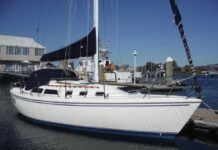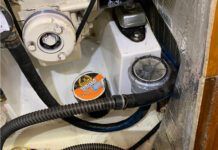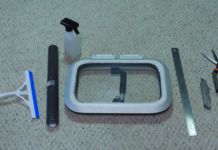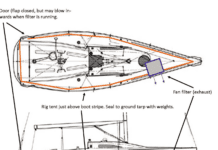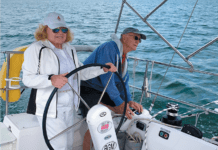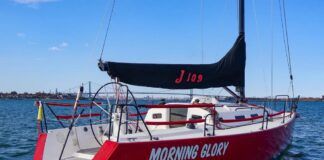Entry-level cruising boats
Excerpted from Practical Sailors ebook, Entry-Level Cruiser-Racers
The C&C 27 followed quickly on the heels of the successful C&C 35. The design is attributed to 1970, with the first boats coming off the line in 1971. The boat evolved through three subsequent editions-the Mark II, III and IV (the latter are hulls #915-#975, according to an owner)-with the latter finishing in 1982. But the hull was essentially the same and not to be confused with the MORC-influenced 27-footer that followed about 1984, with an outboard rudder. That boat lasted until 1987.
The C&C 27 is a good example of what made the company successful-contemporary good looks with sharp, crisp lines that still appeal today. The sheerline is handsome. Below the waterline, the swept back appendages are dated but thats of little consequence to most owners. In the Mark I version, the partially balanced spade rudder is angled aft, with a good portion of it protruding behind the transom. In one of his reviews for Sailing magazine, designer Robert described the C&C 27s rudder as a scimitar shape that was long in the chord and shallow. In 1974, the rudder was redesigned with a constant chord length and much greater depth and less sweep angle.
The keel, too, was redesigned in 1974 though both are swept aft like an inverted sharks fin. The new keel was given 2-1/2 more depth and the maximum thickness moved forward to delay stalling. Hydrodynamic considerations aside, the worst that can be said of the 27s keel is that it takes extra care in blocking when the boat is hauled and set down on jack stands (or poppets as they are called here in Rhode Island). Without a flat run on the bottom of the keel, the boat wants to rock forward.
The rig is a masthead sloop with a P or mainsail luff length of 28 6 and an E or foot length of 10 6; interestingly, this gives an aspect ratio of .36, nearly identical to the .35 ratio of the Tartan 4100 reviewed last month. In response to the September article on skinny masts with single lower shrouds, the owner of a 1974 model wrote, My 1974 C&C 27 has double lowers with a tree trunk of a mast, which I know will support any headsail in any condition, probably even if I drove the boat full steam into an immovable object. Not so the earliest models.
The owner of a 1977 model wrote to say that the Mark I and II models had shorter rigs and more ballast. The change occurred in 1974, along with several others, some of which weve already noted.
Length overall was first given as 27 4; for later marks it is listed as 27 11. Waterline length started at 22 2, increasing to 22 11. The bow overhang is attractive, but more than is found on most boats nowadays. Remember that waterline length directly affects speed.
Displacement, too, changed over the years, between 5,180 pounds,5,500 pounds and 5,800 pounds. (The owner of hull #54 says that boats before #250 were 1,000 pounds heavier.) Depending on which waterline dimension you use, the displacement/ length ratio (D/L) ranges from 211 to 237. The sail/area displacement ratio (SA/D) is between 17.3 and 19.4. With moderate displacement and a generous sail plan, the C&C 27 is fleet. PHRF ratings for the Mark I average around 200 seconds per mile, dropping to about 190 for the Mark II and 175 for the Mark III.
From the C & C 27 review. To read the complete review of this popular sailboat, in addition to ten other entry-level cruisers, purchase and download the ebook Entry-Level Cruiser-Racers, Volume One from Practical Sailor. For a list of the boats reviewed, and details on Volume One of this series, click here.



